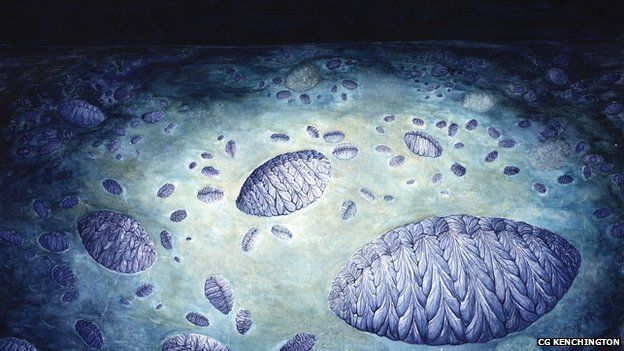Sex life of ancient Fractofusus organism revealed
- Published

One of the earliest complex organisms had a surprisingly complicated sex life, scientists say.
Until now, little was known about the biology of Fractofusus, which lived in the ocean 565 million years ago.
But new research has revealed a dual mode of reproduction. In one method, the organism sprouted young from its body in much the same way that a spider plant or strawberry plant multiplies.
In another, it produced seeds or tiny buds into the water column.
This allowed the ancient life-form to produce clones that could colonise a new patch of seabed.
The study is published in the journal Nature.
Fractofusus - originally called "the Spindle" until it was formally described in 2007 - appeared in the Ediacaran age.
It is among the earliest-known, complicated organisms, emerging from an ocean of simple multi-cellular microbes.
It grew to up to 40cm long and had a flat, oval shape, made up of a series of little branches stretching across the sea floor.
"It has a very distinct body plan that is totally unique," said Dr Emily Mitchell, the paper's lead author, from the University of Cambridge.
"There is nothing like Fractofusus around today, which makes trying to understand anything about it really, really difficult."
She added: "We knew very little, apart from the fact it lived in the deep sea, it has a relatively large surface area - so it got its nutrients from the water column.
"We literally had no idea how it reproduced prior to this study."
An analysis of fossil beds in Newfoundland, Canada, enabled the team to shed light on the organism's sex life.
Dr Mitchell said that while the two modes of reproduction might sound unusual, many plants reproduced in this way.
She added that Fractofusus should not be classified as a plant.
"It certainly wasn't a plant because it couldn't photosynthesise - there was no light (that deep in the ocean)."
Nor was it an animal, she said.
"Fractofusus doesn't exhibit any of the features you associate with an animals. It belonged to a now-extinct eukaryotic group known as rangeomorphs.
"But how rangeomorphs relate to animals and the origins of animals is incredibly difficult to work out."
While the debate continues over where it sits on the tree of life, an unusual mode of sex clearly worked for Fractofusus.
But in terms of evolution, the organism was less of a success.
It died out about 540 million years ago - and nothing like it has ever appeared again.
Follow Rebecca on Twitter.
- Published19 October 2014
- Published26 February 2009
- Published18 September 2007